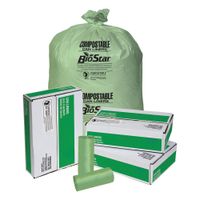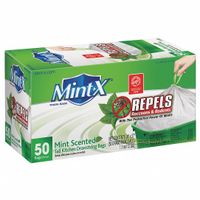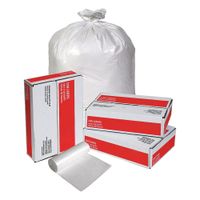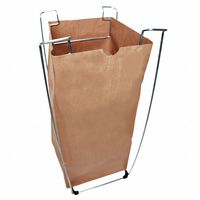Call +(254) 703 030 000 / 751 483 999 / 721 704 777
- Home
- Cleaning And Janitorial
- Waste Recycling Trash Supplies
- Waste Bags Accessories
.....Read More
Frequently Asked Questions
What size waste bag do I need for my trash bin?
To determine the appropriate size waste bag for your trash bin, follow these steps:
1. **Measure the Bin**:
- **Height**: Measure from the bottom to the top edge of the bin.
- **Width**: Measure the widest part of the bin from side to side.
- **Depth**: Measure from the front to the back of the bin.
2. **Calculate the Circumference**:
- For a rectangular or square bin, add the width and depth, then multiply by two.
- For a round bin, multiply the diameter by 3.14 (π).
3. **Determine the Bag Width**:
- Divide the circumference by two to get the minimum width of the bag.
4. **Determine the Bag Height**:
- Add the height of the bin to half of the width to ensure the bag can be folded over the top edge.
5. **Consider the Volume**:
- Check the bin's volume in gallons or liters. Match this with the bag's capacity, ensuring it can hold the bin's full volume.
6. **Select the Right Type**:
- Choose a bag material suitable for the waste type (e.g., heavy-duty for sharp objects, biodegradable for compost).
7. **Check for Fit**:
- Ensure the bag fits snugly without excessive overhang or being too tight.
By following these steps, you can select a waste bag that fits your trash bin perfectly, ensuring efficient waste management.
What are the different types of waste bags available?
There are several types of waste bags available, each designed for specific purposes and waste types:
1. **Standard Trash Bags**: These are the most common and are used for general household waste. They come in various sizes and thicknesses to accommodate different trash volumes and weights.
2. **Recycling Bags**: Typically blue or green, these bags are designed for recyclable materials. They are often transparent to allow easy identification of contents and are made from recyclable materials themselves.
3. **Compostable Bags**: Made from plant-based materials like cornstarch, these bags are designed to break down in composting environments. They are ideal for organic waste and are certified by standards like ASTM D6400.
4. **Biodegradable Bags**: These bags are designed to decompose more quickly than regular plastic bags. However, they may not fully break down in all environments and are different from compostable bags.
5. **Hazardous Waste Bags**: Used for medical or industrial waste, these bags are often red or yellow and are made from strong materials to prevent leaks and contamination. They are labeled with biohazard symbols.
6. **Dog Waste Bags**: Small, often scented bags designed for picking up pet waste. They are usually biodegradable or compostable.
7. **Heavy-Duty Contractor Bags**: Made from thick, durable plastic, these bags are used for construction debris, yard waste, or other heavy materials. They are tear-resistant and can handle sharp objects.
8. **Drawstring Bags**: These bags have a built-in drawstring for easy closure and carrying. They are convenient for household use.
9. **Scented Bags**: Infused with fragrances to mask unpleasant odors, these bags are often used in kitchens or bathrooms.
10. **Clear Bags**: Used where visibility of contents is necessary, such as in recycling or security settings.
Each type of waste bag is designed to meet specific needs, ensuring proper waste management and environmental considerations.
How do I choose the right waste bag for hazardous materials?
To choose the right waste bag for hazardous materials, consider the following factors:
1. **Material Compatibility**: Ensure the bag material is compatible with the hazardous waste type. For chemical waste, use bags made from materials resistant to chemical reactions, such as polyethylene or polypropylene.
2. **Regulatory Compliance**: Check local, state, and federal regulations (e.g., OSHA, EPA) for specific requirements on hazardous waste disposal. Bags must meet these standards to ensure legal compliance and safety.
3. **Strength and Durability**: Select bags with sufficient thickness and strength to prevent leaks, tears, or punctures. Gauge thickness is crucial; typically, a minimum of 3 mils is recommended for hazardous waste.
4. **Size and Capacity**: Choose a bag size that accommodates the volume of waste without overfilling. Overfilled bags are prone to breaking and pose safety risks.
5. **Color Coding and Labeling**: Use color-coded bags to differentiate types of hazardous waste (e.g., red for biohazard, yellow for infectious waste). Ensure bags have clear labeling for easy identification and handling.
6. **Closure Mechanism**: Opt for bags with secure closure systems, such as drawstrings or ties, to prevent accidental spills during handling and transportation.
7. **Temperature Resistance**: If waste is subject to temperature variations, select bags that can withstand the specific temperature range without degrading.
8. **Environmental Considerations**: Consider eco-friendly options if available, such as biodegradable or recyclable bags, provided they meet all safety and regulatory requirements.
9. **Supplier Reputation**: Purchase from reputable suppliers who provide quality assurance and have a track record of compliance with safety standards.
By considering these factors, you can select the appropriate waste bag that ensures safe and compliant disposal of hazardous materials.
What do the different colors of waste bags signify?
Different colors of waste bags are used to signify the type of waste they contain, ensuring proper segregation and disposal. Here’s a breakdown of common color codes:
1. **Black Bags**: Typically used for general waste that is non-recyclable and non-hazardous. This includes everyday household waste like food scraps, non-recyclable packaging, and other non-hazardous materials.
2. **Green Bags**: Often used for garden waste or compostable materials. This includes grass clippings, leaves, branches, and other organic waste that can be composted.
3. **Blue Bags**: Generally designated for recyclable materials such as paper, cardboard, and certain plastics. These bags help in the collection of materials that can be processed and reused.
4. **Yellow Bags**: Used for clinical or infectious waste, particularly in healthcare settings. This includes items like used bandages, swabs, and other materials that may pose a biological hazard.
5. **Red Bags**: Typically used for hazardous waste, including chemical waste or materials contaminated with hazardous substances. This ensures that such waste is handled with care to prevent environmental contamination or health risks.
6. **White Bags**: Often used for the collection of confidential documents that need to be shredded and securely disposed of.
7. **Clear Bags**: Used for recyclable materials where visibility of contents is required, facilitating easy sorting and ensuring compliance with recycling guidelines.
These color codes can vary by region or country, but the primary goal is to promote effective waste management, reduce contamination, and ensure safety in handling and disposal processes.
Are biodegradable waste bags effective?
Biodegradable waste bags are designed to break down more quickly than traditional plastic bags, offering an environmentally friendly alternative for waste disposal. Their effectiveness can be evaluated based on several factors:
1. **Material Composition**: Biodegradable bags are typically made from plant-based materials like cornstarch or other organic polymers. These materials are designed to decompose under specific conditions, such as exposure to sunlight, moisture, and microorganisms.
2. **Decomposition Conditions**: For biodegradable bags to be effective, they require the right environmental conditions. In industrial composting facilities, where temperature and humidity are controlled, these bags can break down within a few months. However, in landfills, where such conditions are not present, the decomposition process can be significantly slower.
3. **Environmental Impact**: When biodegradable bags decompose properly, they can reduce the accumulation of plastic waste in the environment, thus lowering pollution levels. They also contribute to the reduction of greenhouse gas emissions compared to traditional plastic bags.
4. **Limitations**: Despite their potential benefits, biodegradable bags have limitations. If they end up in the ocean or other natural environments, they may not decompose as intended, contributing to pollution. Additionally, some biodegradable bags may leave behind microplastics if not fully broken down.
5. **Consumer Behavior**: The effectiveness of biodegradable bags also depends on consumer behavior. Proper disposal and understanding of how these bags should be used and discarded are crucial for maximizing their environmental benefits.
In conclusion, biodegradable waste bags can be effective in reducing environmental impact when used and disposed of correctly, particularly in controlled composting environments. However, their effectiveness is limited in uncontrolled settings like landfills or natural environments.
How can I ensure waste bags are disposed of properly?
To ensure waste bags are disposed of properly, follow these steps:
1. **Segregation**: Separate waste at the source into categories like recyclables, compostables, and non-recyclables. Use color-coded bags or bins to make this process easier.
2. **Use Appropriate Bags**: Choose the right type of waste bags for different kinds of waste. Biodegradable bags are suitable for organic waste, while sturdy, leak-proof bags are better for general waste.
3. **Labeling**: Clearly label waste bags to indicate their contents. This helps waste management personnel handle them correctly and ensures they end up in the right processing facility.
4. **Secure Tying**: Ensure bags are securely tied to prevent spillage during handling and transportation. Double-knotting can provide extra security.
5. **Designated Disposal Areas**: Dispose of waste bags in designated collection points or bins. Avoid leaving them in unauthorized areas, which can lead to littering and environmental hazards.
6. **Follow Local Regulations**: Adhere to local waste disposal regulations and guidelines. This may include specific days for collection, types of waste accepted, and disposal methods.
7. **Recycling Programs**: Participate in local recycling programs. Ensure recyclable materials are clean and dry before placing them in recycling bags.
8. **Composting**: For organic waste, consider composting at home or using community composting facilities. This reduces landfill waste and produces useful compost.
9. **Hazardous Waste**: Dispose of hazardous waste, such as batteries and chemicals, at designated facilities. Never mix them with regular waste.
10. **Education and Awareness**: Stay informed about waste management practices and educate others in your community. Awareness can lead to better compliance and environmental responsibility.
By following these steps, you can contribute to effective waste management and environmental conservation.
What are the best waste bags for recycling purposes?
The best waste bags for recycling purposes are those that are durable, eco-friendly, and clearly labeled to facilitate proper waste segregation. Here are some top options:
1. **Biodegradable Bags**: These bags are made from plant-based materials like cornstarch and break down more quickly than traditional plastic. They are ideal for organic waste but can also be used for dry recyclables if they meet local recycling guidelines.
2. **Recycled Plastic Bags**: Made from post-consumer recycled materials, these bags help reduce the demand for new plastic production. They are sturdy and suitable for holding a variety of recyclable materials.
3. **Clear Bags**: Many recycling programs require clear bags to easily identify the contents and ensure proper sorting. Clear bags made from recycled or biodegradable materials are a good choice.
4. **Compostable Bags**: Certified compostable bags are designed to break down in industrial composting facilities. While primarily used for organic waste, they can be used for recyclables if they meet local requirements.
5. **Heavy-Duty Bags**: For areas with strict recycling guidelines, heavy-duty bags that resist tearing and puncturing are essential. These bags can handle heavier recyclables like glass and metal.
6. **Color-Coded Bags**: Using color-coded bags can help in sorting different types of recyclables, such as blue for paper and green for glass. This system aids in efficient recycling processes.
When selecting waste bags for recycling, consider local regulations and the specific types of recyclables you need to manage. Always check for certifications like ASTM D6400 or EN 13432 for compostability and look for bags that align with your environmental goals.







